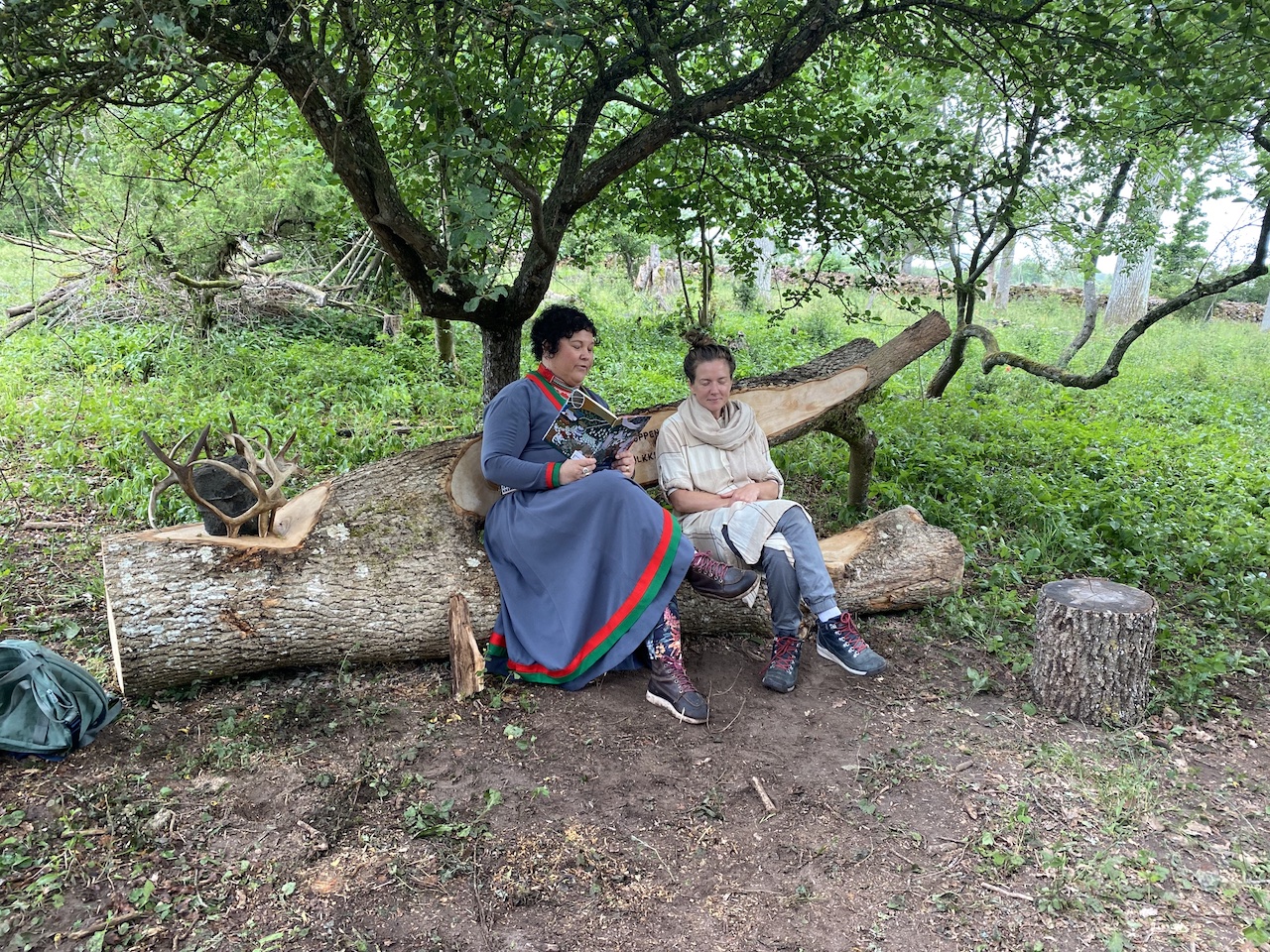
(scroll down for English)
Alla presentationer av verk sker i Skogen, med lättare mat och tilltugg lagad på plats. För de som har svårt att gå ca 500m. utan väg, erbjuder Mittlandets brukshästar skjuts (också för rullstol) ner igenom Skogsbetesmarken. Vi träffas vid Kultdjurhuset på Dyestad bygata 16, och vandrar tillsammans till skogen.
Vi är också mycket glada att vid invigningen få höra Susanne Forslund, naturvårdare vid Länsstyrelsen Kalmar län, projektledare för Mittlandsprojektet och akvarellist, berätta mer om Mittlandets särskilda karaktär. Vad betyder det att vi står i ett kulturlandskap? hur mår det idag, och hur kan vi föreställa oss relationen med landskapet i framtiden?
I samtalet deltar också växtodlare och folkbildare Maria Lindmark, som tillsammans med Mathieu Vrijman startar kursen ”Leva med Skogen” på Ölands folkhögskola i höst. De berättar mer om kursen, och sina tankar runt hur skogsbruk skulle kunna vara både naturvård, matproduktion och en lärandeprocess.
”Fátmmie – öppen famn”
Sara Ajnnak är tillsammans med sin man Jon Andersson aktiv inom rennäringen och de har utvecklat en livsstil som styrs utifrån renens årscykel och årstidsväxlingarna. Jon Andersson är en skicklig hantverkare med ett omfattande kunnande och ett stort intresse för kulturbyggnader av olika slag. Han har mångårig erfarenhet av olika restaureringsprojekt av kulturbyggnader så som kvarn, benstamp, logar osv. och specifika kunskaper om traditionella byggnader och byggnadstekniker från Västerbotten. I den samiska traditionen de lever i och förvaltar har det funnits och finns fortfarande heliga platser i naturen, och Sara och Jon vill genom sin medverkan i projektet En del av landskapet skapa en plats för människor där de kan återskapa sin naturliga relation till naturen, i verket Fátmmie – öppen famn.
”Naturens helande kraft finns där som en öppen famn för människan. I den samiska kulturtraditionen har människor förhållit sig till heliga platser med stor respekt för dess krafter och dess geografiska område. I förberedelserna till vår vistelse i Mittlandsskogen har vi samlat material från vårt närområde som vi vill kombinera med den geografiska platsen på Öland. Vi ser framemot vår vistelse och att fortsätta skapandet av Fátmmie på plats på Öland i sommar.”
Sara Ajnnak, together with her husband Jon Andersson, is active in reindeer husbandry and they have developed a lifestyle that is guided by the annual cycle of the reindeer and the changes of the seasons. Jon Andersson is a skilled craftsman with extensive knowledge and a great interest in cultural buildings of various kinds. He has many years of experience in various restoration projects of cultural buildings such as mills, bone stomps, lodges, etc. and specific knowledge of traditional buildings and building techniques from Västerbotten. In the Sami tradition they live in and manage, there have been and still are sacred places in nature, and Sara and Jon, through their participation in the project Part of the landscape, want to create a place for people where they can recreate their natural relationship with nature, in the work Fátmmie – open arms.
“The healing power of nature is there as an open embrace for man. In the Sami cultural tradition, people have treated sacred places with great respect for their powers and their geographical area. In preparation for our stay in Mittlandsskogen, we have collected material from our immediate area which we want to combine with the geographical location on Öland. We look forward to our stay and to continuing the creation of Fátmmie on location on Öland this summer.”
“Viva Coleoptera” (Long live the beetle)
With his work in Mittlandsskogen, Jonas wants to increase general knowledge of the beetle fauna. Öland has very high entomological values linked to dry and wetlands. The most threatened environments on Öland are unfertilized drylands in the Mittlandsskogen. Many beetles are linked to these environments and the ancient agricultural landscape, which in our time has been largely replaced by more intensive agriculture and forestry and the use of pesticides in our lands. On Öland and throughout Sweden, these species are therefore disappearing and dying out. Through stylized, graphic burn marks in the forest pasture, the work wants to draw attention to the serious situation the beetles (and we) find ourselves in, and highlight the importance of protecting the beetles and their habitats.
“With my work, I want to, in a simple way and from my perspective, spread a little knowledge about which beetles we currently share our world with. I also want to highlight which species are now so threatened that their existence hangs in the balance. I hope to give a little insight into this topic, and that it can be a step in enabling a development where we can see the value of protecting these insects, and that this becomes the rule instead of the exception. The beetles must be given a justification to continue living in the landscape, for the survival of all life forms.”
“The Clay and the Night”
Marlene Lindmark is an artist educated at the Department of Ceramic Art at Kunsthöyskolen in Oslo. She works in drawing, sculpture and mixed media, and is represented in collections and with public works in Kalmar, Mörbylånga, Borgholm, Östersund, Växjö, Antwerp and Oslo. Marlene has also been part of Kultivator since the beginning, and also ran Galleri ML in Borgholm as well as the exhibition operations at Öland’s museum, Himmelsberga. In her contribution to the conversation with Landskapet i Mittlandsskogen, Marlene will focus on the clay under the humus layer, and invite the transformation of it, through the fire, during a whole night of burning in a homemade oven in the Forest. More information will come about “The Clay anfd the Night” closer to the opening date.
https://www.saraajnnak.com/
https://www.arjeplognytt.se/…/sara-prisas-for…/
https://www.instagram.com/jonaswrahm/
https://marlenelindmark.se/
Med stöd av: Kulturrådet
































